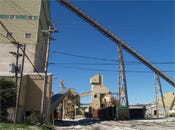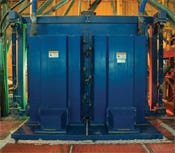October 8, 2007
|
Wedron provided the perfect site for beta testing the APEX, as sand is one of the most difficult applications to screen. |
Wedron Silica, a division of Fairmount Minerals, has been producing round-grain silica sand for more than 100 years. The sand mined at Wedron is used in the creation of proppants, which are used to hold open the fractures made during the oil drilling process in place of the extracted oil. Screening equipment used at the facility in Wedron, IL, faces harsh conditions 24 hours a day, seven days a week.
Rotex Inc., Cincinnati, a global leader in screening technologies, knew that Wedron Silica would put its new APEX dry separation screener to the test. Each day, the screener needed to process more than 150 tons of sand at the Wedron site. The Model A8G35-2 is a 35-sq-ft, two-deck separation screener making a sharp cut in product between 40 and 70 mesh.
Listening Leads to Innovation
“We listened to our customers and the feedback they gave us,” says Rob Scheper, business development manager with Rotex. “They wanted a screener that was easier to access and required fewer people to maintain. That led us to design and engineer the APEX.”
|
Fairmount Minerals’ Wedron Silica Co. has been in operation for more than 100 years. |
|
At Wedron Silica, hundreds of tons of mined sand are diverted in the screening tower. |
Rotex engineers started with the basic design of the APEX screener. The unit uses a unique gyratory-reciprocating motion that allows the machine to process material at a high capacity and improves screening performance for near-sized particles. There is no vertical component to this motion, which keeps the material in constant contact with the screen surface.
“Most screeners use one large screen per separation,” says Scheper. Changing this screen from the top or tail end of the machine is cumbersome. Often the only way to inspect or replace a screen is to have a crane or several people on hand to help lift and remove the top cover and screen. The process is labor intensive and slow, consuming a significant portion of production time.
Reduced Screen Size Increases Ease of Use
Rotex engineered a screen that can be maintained by just one person while keeping the optimal level of screen performance and life. It was designed with side access to the interior of the machine, using a series of smaller screen panels.
“We divided the large screen into smaller, easier-to-handle panels and created a one-man operation,” says Scheper. The total number of panels on a deck of the APEX depends on the size of the machine. The APEX screener at the Wedron site provides 35 sq ft of screen area, with four panels per deck.
“We worked on the panel size to assure the optimum level of performance and life,” says Scheper. “The tension on the screen is also important. Each panel is pretensioned and each section of the screen is matched up with the mesh cleaning balls in the tray to create a strong seal so there is no leakage.”
Weighing only 5 lb, each screen measures 30 × 42 in. and is available in sizes ranging from ½ in. to 325 mesh. “This is an easy size for one person to handle,” says Scheper. “We decided on this size because you can use a standard roll of screening cloth when you replace the screen and there isn’t much waste, a real savings for our customers.”
Tested Under the Harshest Conditions
|
The ergonomic design of the APEX enables the screener to be maintained by just one person. |
Rotex tested the APEX to make sure it would deliver the quality and performance needed. “Wedron provided the perfect site for testing the APEX,” says Scheper. “They separate a large volume of sand on a daily basis. Due to its abrasive nature, tendency to blind, and difficulty to separate by size, sand is one of the toughest applications available to test the APEX screener.”
At Wedron Silica, 150 tons of mined sand is diverted in the screening tower to the cable-mounted APEX, which runs approximately 20 hours each day. The four hours of downtime are used for maintenance on other machines used in the process.
“It has a small footprint and makes a very efficient particle-size cut,” says David Bach, production superintendent for Wedron Silica. “Maintenance of the screen cloth is a lot friendlier, too. Now we can change a single worn-out screen panel or complete an inspection of this screener with one person. This is not possible with our other machines.”
Improved Functionality and Increased Profits
|
The APEX screener at the Wedron site provides 35 sq ft of screen area, with four panels per deck. |
“Process uptime has increased and the entire process is more efficient,” says Bach. The APEX requires significantly reduced maintenance resources, limited to changing screens and ball trays and greasing the slide bearings. Further engineering improvements include designing the door closures and sealing with strong, easy-to-operate clamps and hinges.
“We looked at a variety of ways to remove screens,” says Scheper. “What made the most sense for the customer was to design the machine with side access.” The doors are located at waist level, allowing for easy access to maintain the screens, seals, and ball trays.
“One of the best features is that one operator can open the doors and pull out a screen,” says Bach. “The reduced manpower and time needed to maintain the screens, seals, and ball trays translates into increased production time and stronger profit margins, too.”
“It would usually take one to two people two hours to change a full-sized screen on a screener,” explains Scheper. “With the APEX unit a deck (four panels) can be changed by one person in about 10 minutes. You’ve just gained one hour and 50 minutes of operation time and saved valuable employee hours.”
Significant Support
|
Fairmont Minerals also operates several Rotex Minerals separators at the Wedron site. |
“We also changed the ball tray design to make it easier for one operator to work with the tray,” says Scheper. “The ball tray weighs only 37 lb and APEX is designed for side access. Removable side arms support the full weight of the tray, allowing the operator to easily perform maintenance tasks.”
“Ball trays on other machines need two people and specific hand tools to move,” says Bach. “APEX ball trays use only one piece that one person can easily manage. You just slide the ball trays out onto the support arms. It’s easier, and with a greatly reduced risk of worker injury or strain. The interface between the operator and the machine is much less labor intensive.”
The operator can inspect the seals and the screens by opening the side access door. “We run the APEX 24/7 during testing to check for quality issues,” says Bach. “Then we take a close look at the screens and replace the bad screen cloths. It’s a lot easier to maintain, and there’s a reduced risk of injury because the machine consists of smaller, easier-to-handle components.
“Since it’s so much easier to change screens, you’ll quickly find more uses for that piece of equipment. You open the side access door and you’re in and out in just a few minutes. Changing the screen panels on the APEX is a piece of cake.”
Rotex Inc. offers a line of separation equipment that includes gyratory and vibratory screeners and sifters for dry applications, liquid-solid separators for wet applications, automated particle-size analyzers, and vibratory feeders and conveyors. For more information, call 800-453-2321 or visit www.rotex.com.
You May Also Like








